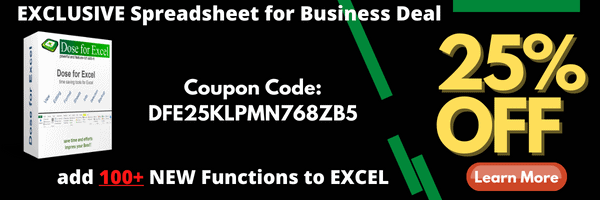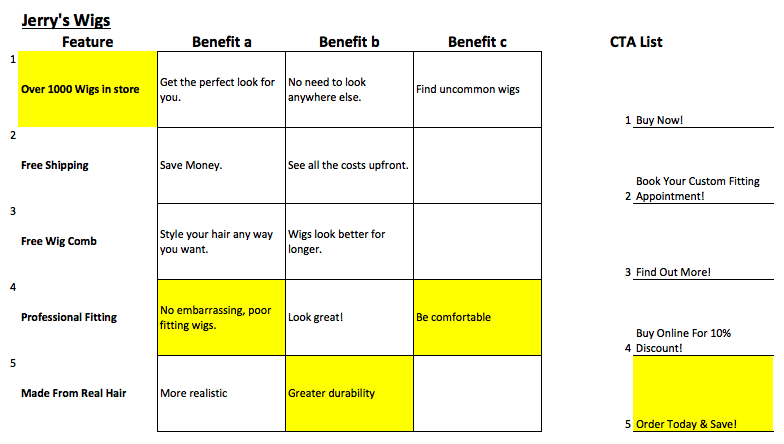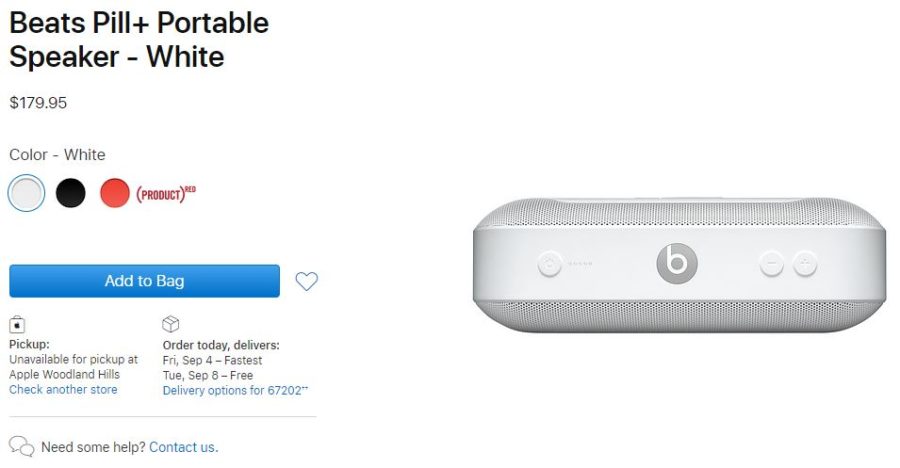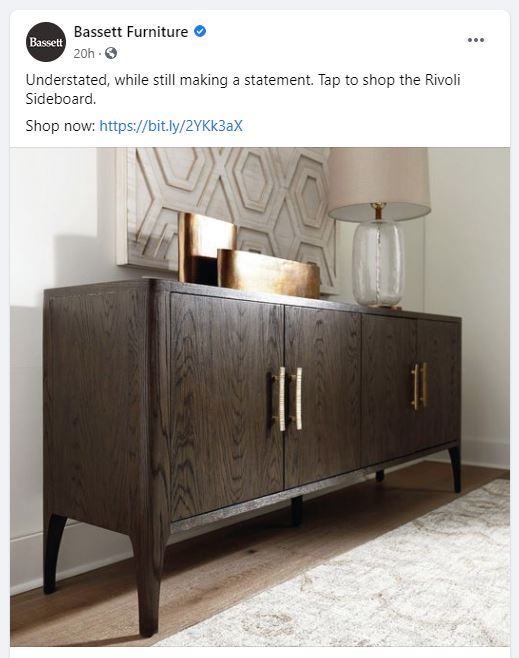
Features are facts about the product or service you’re selling. Features are objective. Entrepreneurs, marketers, and small businesses sometimes emphasize features when they should be emphasizing benefits. Features describe, but it’s benefits that generate sales.
Benefits tell the customer “what’s in it for them?” Benefits are subjective.
Before you write the products and services section of your business plan, stop to think for a moment. If you are already in business, then think about your current marketing, social media, and other places where you are describing products and services.
The temptation when describing products and services is to talk about what they do. That’s just human nature, I suppose. But, those are the features and those aren’t what sells products and services.
It may be you’ve internalized the benefits of those features. So, they’re not at the forefront of your mind. You know what the benefits are intuitively and abstractly. But, can’t quite verbalize them. That’s okay. This post is designed to help you convey to the readers of your business plan why consumers will buy your products or services.
Even though you’ve worked so hard to build a product or service with lots of useful features, you should avoid dwelling on those. You have to focus on how it will improve your customers’ lives. At least for the sake of marketing.
Remember, the business plan is also a marketing document.
Features vs. benefits
Put another way, what a product or service does, are its features. Conversely, how it improves customers’ lives, are its benefits. The two concepts are certainly linked. But, yet, very different.
It pays off, from the get-go, to focus on the customer. Showing the reader of your business plan that you know your customer will help convince them that you can succeed. Think about what goal the customer wants to reach. What is their intent? Because, you could create the greatest thing ever, but if it doesn’t serve anybody’s needs – it won’t sell.
The distinction between features and benefits can be pulled from real-life examples all around us. Sometimes the difference between features and benefits is subtle. So, be wary of slipping into the comfortable trap of trying to market your features.
For the sake of simplicity, I’ll simply be referring to “products” in the rest of this post rather than “products and services.” However, all of the same principles will apply to services as they do for products.
What’s the difference between features and benefits?
Likely, you’re already aware, in general terms, of the differences between features and benefits. But, here’s another way to think about it…
Features are facts. They’re objective and the same for everyone.
Benefits, on the other hand, answer the customer’s question: “what’s in it for me?” They’re subjective and appeal to a customer’s emotions.
That said, let’s go into a little more detail.
What do you mean by features?
You can think of a feature as something your product possesses. Or, something that your product is.
Consider a personal computer. What features might it have? Well, it might have an advanced processor (characterized by GHz, cache, or cores). It might have a hard drive with a lot of space (characterized by TB or solid-state). Additionally, it might have a lot of memory (characterized by GB).
These features are positive. The more the better, generally speaking.
The company that built the PC should be proud to sell a product that has these features. But, a list of features like that says nothing about why a person purchasing a computer should care. Especially a layman – somebody who is not well educated in computer features.
What’s the benefit of one more GHz, core, TB, or GB? How about five more? Most customers won’t know. At least, until you tell them.
It’s the benefits that those features provide that will sell the PC.
What are examples of benefits?
Benefits are the experiences that the customer will have from using your product. It’s the justification that they will use to part with their hard-earned money.
Customers don’t make purchases just for the sake of buying something.
Let’s think about the PC again.
Having a processor with high GHz and several cores means that the computer will work faster. It will accomplish what the user wants in a more timely manner. It can handle newer and more sophisticated software.
A larger hard drive means that the customer can store more information on the computer. More programs, more media, more of whatever it is they’re using the computer for.
Finally, more memory also means quicker operation. Less frustration. Less of a risk of crashing.
All of these benefits translate into a customer being able to do more on their computer. It means less worry about the software they use on their computer. It means being able to accomplish whatever goals prompted them to purchase a computer in the first place.
Hopefully this example illustrates how benefits give context to features.
The fuzzy line between features and benefits
Sometimes, what constitutes a feature or a benefit is clear-cut. Other times, not so much. For some features, it can be difficult to convey the benefits in an appropriate manner.
Products that are status symbols can have such a problem. It could be tough to say that the benefit of a product is that the customer’s friends and family will be jealous of them. That casts the customer in a negative light. It implies that they are egotistical and/or superficial. However, that might be, deep down, the reason they would purchase a given product. For the status it conveys.
You might spend a lot of time thinking about and researching the problems that your product will solve. That doesn’t mean, however, that those benefits will be obvious to the customer. After all, look at all the effort it took for you to find the problems. So, you can’t necessarily be surprised if the customer doesn’t immediately recognize that they have those problems.
Feature-benefit matrix
Still not sure how you’ll isolate benefits from features? You can use a tool called a feature-benefit matrix.
A feature-benefit matrix is pretty simple. It’s simply a grid where you list features in the first column. Then, for each feature, you can list benefits in the following columns. Additionally, some feature-benefit matrices will have another column where you can list a call to action for each feature and benefits. This is good if you can think of a short phrase that would prompt customers to buy based on the benefits you just listed.
Not every feature is going to have three benefits. So don’t rack your brain trying to fill in the entire feature-benefit matrix.
What this tool does, however, is allow you to get those benefits down in writing. This allows you to reference them later when you address the marketing and sales section of your business plan. This useful document can also be given to other individuals in the company (or outside of it) who may draft marketing messages for you.

Features and benefits for products
Let’s take a look and some real-life examples of product descriptions. The reader of your business plan is going to want to know what exactly it is that you’re selling. By scrutinizing these examples, hopefully, you will see how the descriptions can help the reader believe that your products are going to sell. Your business plan can show that the way you describe these products will help you be successful
First, though, a distinction needs to be made between what I would call advantages and benefits.
To me, advantages are implied benefits. They tell you why a feature is good. But, they don’t quite solidify how the feature will make you feel. Advantages are a kind of benefits-lite. They leave something to the imagination. They’re the bridge between features and benefits.
All this doesn’t necessarily mean that advantages should be omitted. It’s just that your point might not quite be hitting home if you rely on communicating advantages rather than benefits.
For each product, we’ll look at the first three features mentioned. Then, we’ll make a judgment to decide if the benefits of those features have been adequately highlighted.
American Girl dolls features and benefits
The first product I’ll look at is American Girl dolls. Having raised a couple of daughters, I know that doll quality can range from dollar-store-level to very high-end. With the American Girl dolls being on the higher end of that spectrum.
Dolls have been around forever. And, as you’ll see, they can have a lot of intricate parts. American Girl has the unique challenge of having to market to two separate groups of people. The individual who will play with the doll and, the individual who will actually pay for it.
The first feature mentioned is hair. I can’t help but notice how they don’t elaborate on the features here. It’s just “hair.” Not “high-quality mod-acrylic life-like hair” (or something of the sort). The paragraph that follows states how the hair is actually a firmly-secured wig. Additionally, how it’s similar to high-quality wigs that people might use.
In my eyes, these are only advantages. The implication of these advantages is durability. After this, they do list some actual benefits, however. They state how the hair can be styled and has a realistic variation of colors. I think this is a benefit because it conveys realism. Which, I know from experience, would be appreciated by the little girls pretending to take care of a baby.
The next feature mentioned is the eyes. Firstly, they mention the advantage that they operate smoothly. Implying that they’re not likely to get stuck open or shut. After that, they discuss benefits similar to the hair. Namely how they are designed to be as realistic as possible.
The third feature mentioned is the face. Here, they toot their own horn a little bit about how long it takes to create the faces (more than a year). Which, as addressed above, is generally pointless. The customer doesn’t care. Perhaps it might impress the customers who are craftsmen. It won’t, however, impress any of the girls who play with the dolls.
The benefit of the way the faces are designed is the same as the other features – the realism. It seems that this is one of the benefits that the company wants to focus on. Admittedly, a benefit could be appreciated by the actual users of the product – the young girls.
Apple Beats Pill+ features and benefits

The second product we’ll look at is the Beats Pill+ portable speaker from Apple. This is a modern product with a lot of technologically advanced parts – unique among the examples we’re looking at.
The first thing you might notice is Apple’s emphasis on benefits for this product. At least when compared to the other two. Rather than mentioning a feature and then backing it up with advantages and benefits, Apple draws attention to the benefit/advantage.
The first benefit mentioned is that the Beats Pill+ has “sound bigger than its size.” This tells us that the speaker can get loud, but won’t take up much space. The features that facilitate that benefit are then addressed. The speaker has a two-way crossover system along with tweeter and woofer separation.
The second benefit is a little vaguer. It’s that the Beats Pill+ is “designed around you.” Personally, I think that’s a weird phrase. I know, of course, that this product wasn’t designed for me as an individual. In the description that follows, they mention that “it looks as good as it sounds.” Apple, obviously, prides itself on design. So, I know their customers are concerned about that. But, I’m just not sure how important the looks are beyond a certain point.
They do go on to mention the “simple, intuitive interface” which allows you to get to your music fast. That’s a more genuine benefit, in my opinion, and something they should have focused on more.
The last feature is “pair and play.” Again, this strikes me as a little odd. Almost anybody who’s going to purchase a Bluetooth speaker understands how they work. They elaborate on this by mentioning all the different devices that you can use to play music on the Beats Pill+. Again, not anything revolutionary. But, I suppose the implication is that the speaker is versatile. In fact, I think the point they’re trying to make is that this speaker will work with devices that aren’t manufactured by Apple.
Lowe’s Craftsman Shovel features and benefits
Here is a relatively simple product; a commodity really. Nevertheless, you’ll notice that Lowe’s does make the effort to highlight this product’s features and how they are beneficial.
The first feature mentioned is the round point blade. The advantage given is that it’s ideal for digging a variety of holes. What’s that mean? I believe it’s implied that you can dig a tapered hole for instance. Or, maybe a hole with different levels? I think the point is versatility.
The next feature listed is the “secure” step. This feature has a little more of a defined benefit. The secure step allows for “solid food placement for added digging force.” The implied benefit being, I believe, that it won’t cut into the sole of your shoe when you step on it.
Also, your foot won’t slip off when pushing the shovel into the ground. The term “added digging force” implies that you can easily cut through hard ground and lessen the amount of effort needed when shoveling. If you’ve ever dug a proper hole, you know that you can use all the help you can get.
The last feature is the “power collar.” I assume this is part of the joint that links the shovel head and the handle. Again, I would classify the “secure shuffle blade to handle connection” as more of an advantage than a benefit. The implied benefit is that your shovel won’t break on you.
You’re counted on to know that a broken shovel means you will have to buy another, at best. At worst, it means getting injured. A “secure shuttle blade to handle connection” also implies durability, quality, and the potential to last a long time; therefore giving you good value for your money.
Features and benefits in ad copy
Yes, this post is about the product and service section of the business plan. No, it’s not about the sales and marketing section. That will be covered in the coming weeks.
At some point, you’re going to have to market these products beyond writing simple descriptions. So, while we’re on the topic of features and benefits, I thought I should touch briefly on advertising.
As with products, we’ll take a quick look at three separate pieces of advertising. Each is chosen from different online mediums. We’ll try to discern how effective the advertising is and highlight the benefits vs advantages vs features. These examples were chosen, more or less, at random.
Whirlpool washing machine search engine ad features and benefits

The first line of the ad mentions a “variety of styles and sizes.” The advantage of a variety of sizes implies that Whirlpool has a washing machine that will fit wherever you need it. Personally, I think this barely qualifies as an advantage because it’s not a benefit of ownership. It’s a prerequisite to ownership.
Next, the word “features” is explicitly used. You, the reader, are invited to explore Whirlpool’s innovation and to learn more. No mention is made of what benefits these features will provide. I guess since the word “innovative” is used, you’re supposed to assume that they’re beneficial.
The ad wraps up with the phrase “seamless smart home.” Which doesn’t mean much to me personally.
I guess they might have been running out of character space and simply plugged the catchphrase in there to avoid wasting it. Which, I can kind of understand. Nevertheless, I think the space could have been used more effectively.
Bassett Furniture Facebook post features and benefits

This is actually a Facebook post by Bassett. So, not technically an ad. However, it’s still serving a similar purpose.
This advertisement has very little text. Of course, a picture can be worth a thousand words. Particularly when you’re dealing with something like furniture. A lot of the benefit derived from something like this is how it looks. It’s the feeling people get from owning beautiful things and the status that brings. That is something that’s tough to convey in words alone.
The little text that they do utilize doesn’t really convey any advantages or benefits.
I guess the feature of being “understated” implies that this piece of furniture is not so bold that it can’t work with a lot of different decorating styles?
The irony of the whole ad is – since the picture is conveying the benefits of the style, why not use the text to highlight other benefits? Things such as the furniture being durable (resistant to wear and tear)? Or that it’s made of solid wood (would retain its resale value)? Perhaps its storage capacity? A benefit that could allow its owner to feel more organized?
Target banner ad features and benefits

Lastly, we have another ad that’s predominantly image-based.
Here, we are given an advantage of being able to check things off our to-do list. The implication being a sense of relief after getting a pesky chore off your back.
While this is, indeed, a good feeling, that’s not what they say. They merely imply how I will feel rather than saying something like “back to school anxiety relief.” Then, they could follow up with clarification using the same line as they did in the ad – “shop high school must-haves.”
A lot of the space is used up by tiny images of these high school must-haves. Most of which are almost too small to make out. This space might’ve been better used for more benefit-based text.
Products and services example
If you’ve read any of my other business plan posts, you know that I try to put what I write about into action. A lot of this material is new to me so, I feel, in order to really learn it I need to do it.
I have a hypothetical startup that I created. This business has only one product and it is an all-natural, topical hair regrowth supplement. Many of my previous posts explain it in more detail.
In any event, here’s how I might describe my product in my business plan using the principles described above.
Hair regrowth supplement – topical, all natural
Topical treatment to help men and women regain their confidence. A one-of-a-kind supplement for hair loss. Utilizes a scientifically tested ingredient not found in any other therapy. No pricey doctor’s appointment needed. No side effects. No shame.
This is the first pass and is a little more “advertisy” than I want. But, if I can sell the reader of my business plan on it, I can probably sell customers on it. I used a lot of the information I gathered during the demand analysis stage.
Anyhow, I think it accurately conveys what the product is, it’s benefits, and the features that provide those benefits.



